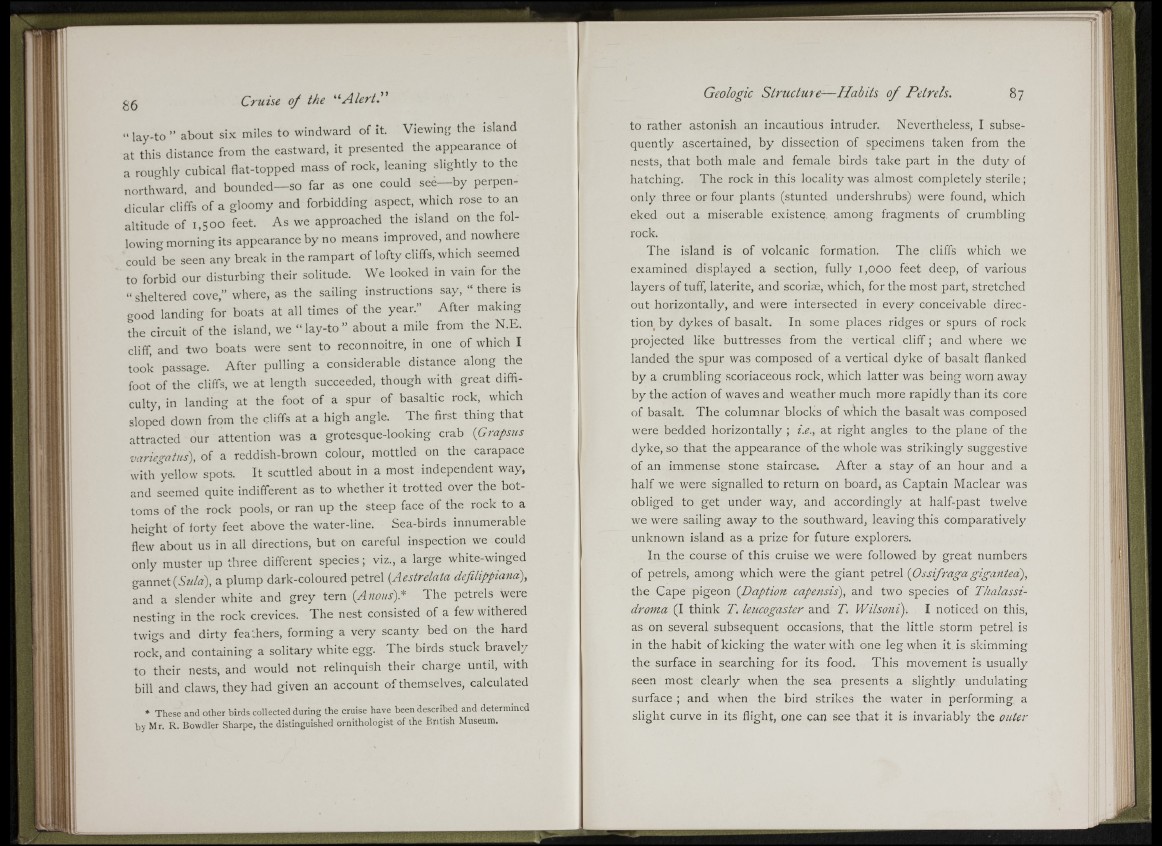
W
l.>! I
1 «
l i l
mA
’¿h:»'
•T
:î .
i
.7a'<
i
js;:
g5 Cruise of the “ Alert.”
“ lay-to ” about six miles to windward of it. Viewing the island
at Uiis distance from the eastward, it presented the appearance of
a roughly cubical flat-topped mass of rock, leaning slightly to the
northward, and bounded— so far as one could see— by perpendicular
cliffs of a gloomy and forbidding aspect, which rose to an
altitude of 1,500 feet. As we approached the island on the following
morning its appearance by no means improved, and nowhere
could be seen any break in the rampart of lofty cliffs, which seemed
to forbid our disturbing their solitude. We looked in vam for the
“ sheltered cove,” where, as the sailing instructions say, “ there is
good landing for boats at all times of the year.” After making
die circuit of the island, we “ lay-to ” about a mile from the N.E.
cliff, and two boats were sent to reconnoitre, in one of which I
took passage. After pulling a considerable distance along the
foot of the cliffs, we at length succeeded, though with great difficulty,
in landing at the foot of a spur of basaltic rock, which
sloped down from the cliffs at a high angle. The first thing that
attracted our attention was a grotesque-looking crab {Grapsiis
■variegatus), of a reddish-brown colour, mottled on the carapace
with%llovv spots. It scuttled about in a most independent way,
and seemed quite indifferent as to whether it trotted over the bottoms
of the rock pools, or ran up the steep face of the rock to a
height of iorty feet above the water-line. Sea-birds innumerable
flevv about us in all directions, but on careful inspection we could
only muster up three different species; viz., a large white-winged
gannet(ST/T. ^ pHmp dark-coloured petrel {Aestrelata defilippiand),
and a slender white and grey tern (A n o o s f The petrels were
nesting in the rock crevices. The nest consisted of a few withered
twigs and dirty feathers, forming a very scanty bed on the hard
rock, and containing a solitary white egg. The birds stuck bravely
to their nests, and would not relinquish their charge until, with
bill and claws, they had given an account of themselves, calculated
* These and other birds collected during the cruise have been described and determined
by Mr. R. Bowdler Sharpe, the distinguished ornithologist of the British Museum.
Geologic Slructure-— Habits o f Petrels. 87
to rather astonish an incautious intruder. Nevertheless, I subsequently
ascertained, by dissection of specimens taken from the
nests, that both male and female birds take part in the duty of
hatching. The rock in this locality was almost completely sterile ;
only three or four plants (stunted nndershrubs) were found, which
eked out a miserable existence, among fragments of crumbling
rock.
The island is of volcanic formation. The cliffs which we
examined displayed a section, fully 1,000 feet deep, of various
layers of tuff, laterite, and scoriæ, which, for the most part, stretched
out horizontally, and were intersected in every conceivable direction
by dykes of basalt. In some places ridges or spurs of rock
projected like buttresses from the vertical cliff ; and where we
landed the spur was composed of a vertical dyke of basalt flanked
by a crumbling scoriaceous rock, which latter was being worn away
by the action of waves and weather much more rapidly than its core
of basalt. The columnar blocks of which the basalt was composed
were bedded horizontally ; i.e., at right angles to the plane of the
dyke, so that the appearance of the whole was strikingly suggestive
of an immense stone staircase. After a stay of an hour and a
half we were signalled to return on board, as Captain Maclear was
obliged to get under way, and accordingly at half-past twelve
we were sailing away to the southward, leaving this comparatively
unknown island as a prize for future explorers.
In the course of this cruise we were followed by great numbers
of petrels, among which were the giant petrel {Ossifraga gigantea),
the Cape pigeon {Daption capensis), and two species of T/ialassi-
droma (I think T. leucogaster and T. Wilsoni). I noticed on this,
as on several subsequent occasions, that the little storm petrel is
in the habit of kicking the water with one leg when it is skimming
the surface in searching for its food. This movement is usually
seen most clearly when the sea presents a slightly undulating
surface ; and when the bird strikes the water in performing a
slight curve in its flight, one can see that it is invariably the outer